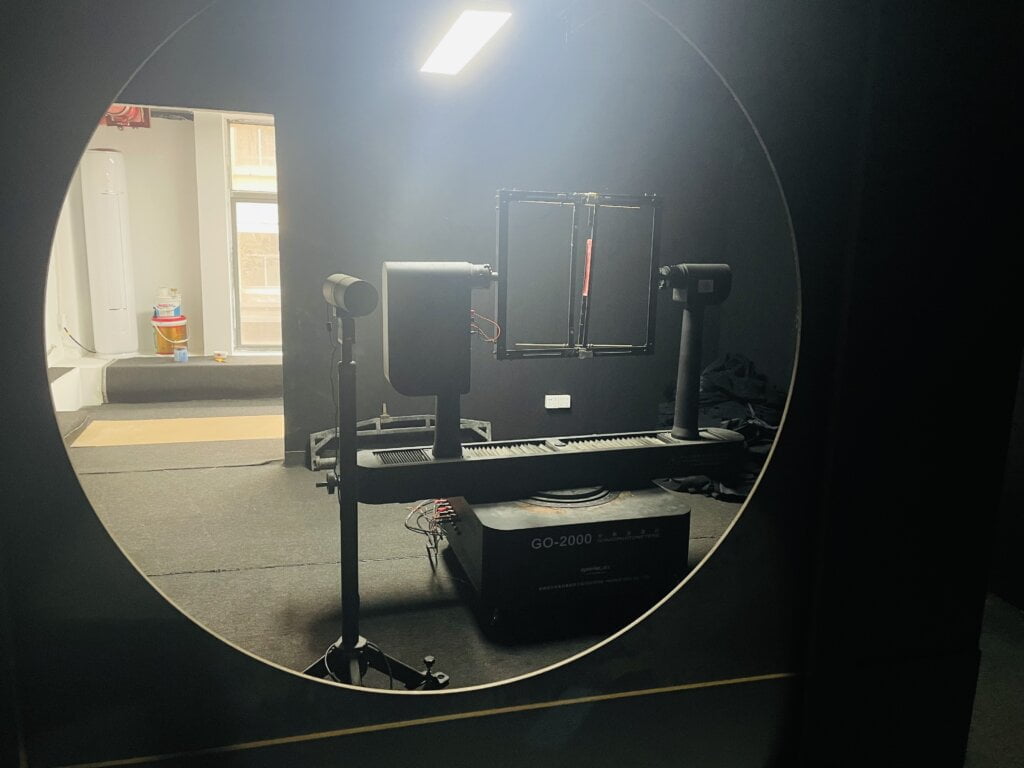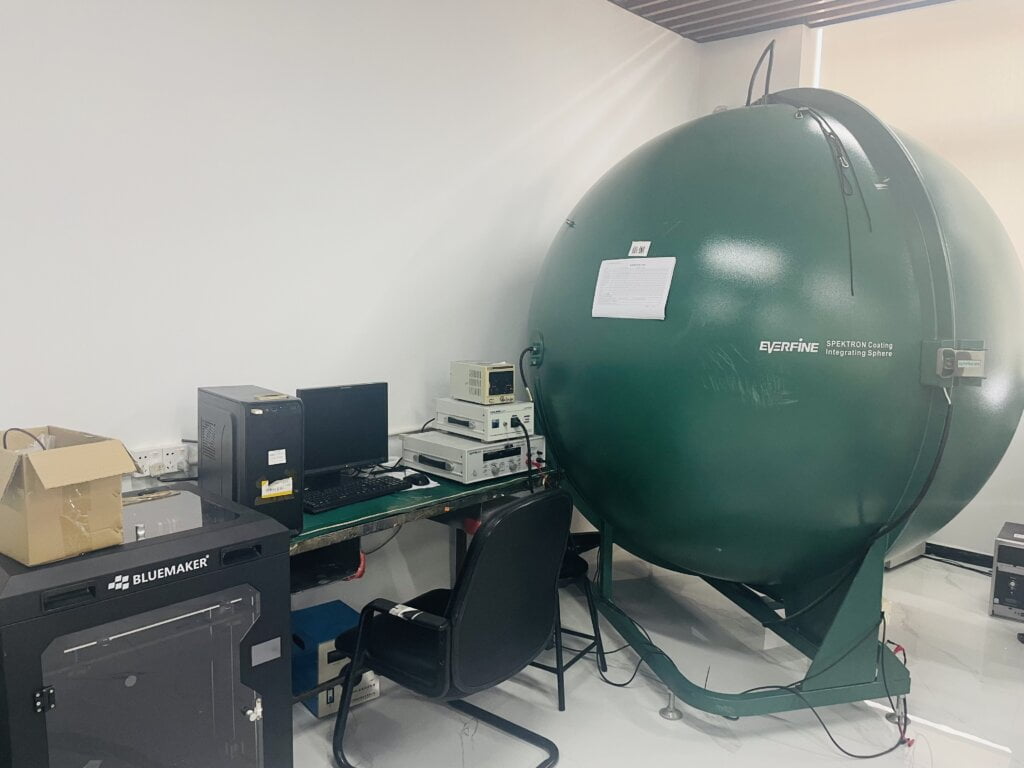LED Lumen Differences: Integrating Sphere vs. Goniophotometer Comparison
Table of Contents
In CIE121: 1966 Clause 6.1 and CIE127-2007 Clause 6.2 and IES-LM-79-08 Clause 9.0, two test methods are mentioned for evaluating LED luminous flux. One approach involves utilizing an integrating sphere in conjunction with a photometer or a spectroradiometer. The integral method is a relative measurement for assessing the total luminous flux (CIE121: 1966 Clause 6.1.1, CIE127-2007 Clause 6.2.2, and IES-LM-79-08 Clause 9.0). The other method employs a goniophotometer known as the photometric method for measuring the absolute luminous flux.
We observe significant differences in the total brilliant flux data when we compare the test results obtained using these two approaches for the same lamp. This article explores the disparities in lumen testing between LED lamps conducted within an integrating sphere and a goniophotometer.
Integrating Sphere Testing (Integral Method)

IES Laboratory
The integral method tests the total luminous flux by calibrating a standard lamp. The spectral output of the sphere is not required as the calibration is done with traditional light. The tested LED lamp product’s luminous flux φTEST (λ) is calculated by comparing it with the conventional lamp. The integration method is commonly used for small integrated LED lamps and relatively small LED light sources to measure total luminous flux and chromaticity parameters. This method offers advantages such as fast measurement speed and does not require a darkroom. The accuracy of the test result increases with smaller volume and closer proximity to a point light source.
However, testing larger-sized LED lamps using the integral method has significant limitations compared to the photometric method. The test fixture used plays a crucial role as LED lamps come in various forms, including bare light sources, spherical bulbs, and different types of LED lamps, which greatly influence the final luminous flux test. Calibration of the integrating sphere is also necessary when using the integration method. Ideally, the standard lamp should have similar brilliant characteristics to the tested light, and a durable white LED is the best choice. While other lamp types can be used for calibration, it may affect the calibration accuracy.
Another difference lies in the test method itself. If the lamp being tested emits light in all directions, a 4π test method is employed by placing the lamp at the center of the integrating sphere. This method yields the best results. However, for directional lighting lamps such as LED panel lights or LED street lights, a 2π test is required, placing the lamp on the side of the integrating sphere (IESLM-79-08 Clause 9.2.5). Suppose the lamp or lamp housing occupies a significant portion of the giant lamp size during testing. In that case, a self-absorption effect may need to be compensated with auxiliary lamps (IESLM-79-08 Clause 9.1.5).
In summary, the integration method is suitable for small integrated LED lamps and relatively small LED light sources, ensuring the accuracy and stability of total luminous flux results. However, when testing large-sized LED lamps, the integral method has significant limitations, leading to uncertainty in the final brilliant flux test.
Goniophotometer Testing (Photometric Method)

Integrating Sphere-2
The spectrophotometric test called Total Luminous Flux Distribution Photometry is rarely limited when measuring the total luminous flux. This test relies on a photometer to measure the intensity of light emitted by a source in various directions or at a specific distance from the start. The total luminous flux can be calculated by gathering light intensity data from different directions. Unlike the integral method, the photometric method is theoretically error-free due to its consideration of the intensity distribution of the tested light source. Consequently, it serves as an absolute test method for measuring the total luminous flux of LEDs. This method does not require a standard for total luminous flux, but it does take longer to measure each sample.
When adopting the photometric method, goniophotometer testing may involve Type C goniophotometers (defined in IES-LM-79-08 Clause 9.3.1 and CIE121: 1996 Clause 3.2), darkrooms, and testing distances (defined in IES -LM-79-08 Clause 9.3 and CIE121: 1996 Clause 6.2.1.4), among other factors. The type of goniophotometer, testing methods (CIE121: 1996 Clause 3.4.2, Clause 3.4.1, Clause 3.4.3), testing distances, and photometric probe lights are the main factors affecting the total luminous flux output variations of the goniophotometer. The related testing methods or equipment can be adjusted to accommodate different types of LED products. For example, when dealing with LED products with a narrow beam angle, you can use smaller Type C goniophotometers, adjust the testing distance, and choose a higher level of L-type photometric probes to achieve high-precision testing of the total luminous flux.
The photometric test offers the highest level of precision in measuring the total luminous flux of LEDs. In contrast, the integration method has inherent limitations, and its errors can only be minimized rather than wholly eliminated through equipment adjustments. Fortunately, the photometric test does not impose significant equipment limitations, and any mistakes can be compensated for by improving the modulation and operation of the equipment.
Comparison and Additional Notes
As previously explained, one of the simplest ways to measure the luminous flux of LEDs is by employing an integrating sphere photometer. This apparatus integrates spatial change visually and facilitates quick and easy measurement of the total quantity of light passing through. Calibration of the integrating sphere photometer is achieved by employing a common light source for total luminous flux. The test light source is compared with a standard light source with a similar spatial and spectral distribution. It is important to note that this method necessitates using a common light source calibrated precisely for luminous flux. While this approach enables fast testing compared to the light distribution tester, errors can arise when the spatial intensity distribution of the tested LED differs significantly from that of the standard light source. Unfortunately, correcting such errors can be challenging, making it crucial to minimize this type of error through meticulous design and similar standard LEDs.
Furthermore, as mentioned earlier, the accuracy of the integrating sphere test is enhanced when the shape of the test fixture closely resembles that of a point light source. Therefore, when measuring the lumen value of various lamps, such as bulb lamps, small LED lamps, integrated LED lamps, and lamp tubes with a beam angle greater than 180°, employing an integrating sphere with a spectrometer for 4π testing is recommended. On the other hand, for larger panel lights, translucent lights, traffic lights, and lamps with a beam angle of less than 180°, using an integrating sphere for testing becomes more complex. In such cases, an integrating sphere with side openings for 2π testing or auxiliary lights for assistance may be necessary, making the testing process tedious and less sure.
The most accurate testing method for these lamps involves utilizing a goniophotometer with a standard darkroom, as it can provide more precise luminous flux measurements. However, it is essential to consider that the test procedure may differ depending on the type of lamp being evaluated, such as C-γ testing for panel lamps and B-β testing for traffic lights and spotlights. Additionally, using a standard darkroom requires a more specialized testing environment and trained personnel than the integrating sphere test.
Conclusion
In conclusion, the principles, environment, and test methods of integrating sphere photometers and goniophotometers differ significantly, and the measurement results obtained from each process are not directly comparable. Selecting an appropriate testing method based on specific standards and requirements is crucial.
MyLiKeLED specializes in the production of top-notch LED strips and LED neon flex. Every single one of our products undergoes rigorous testing in state-of-the-art laboratories to guarantee exceptional quality. Furthermore, we provide customizable options for our LED strips and neon flex. If you need a premium LED strip and LED neon flex, don’t hesitate to contact MyLiKeLED immediately!

Hi, I’m Xylia Xiong, a sales professional with 14 years of experience in the LED strip light industry. I specialize in providing tailored solutions, leveraging my expertise in LED products and the latest industry trends. Known for effective communication and problem-solving, I’m dedicated to helping lighting manufacturers, importers, and distributors achieve their goals.
Let’s work together to create customized solutions that exceed expectations.
Related Posts

The Best LED Strip Lights You Can Buy Right Now

Comparing WS2811 Vs WS2812B: Key Differences


